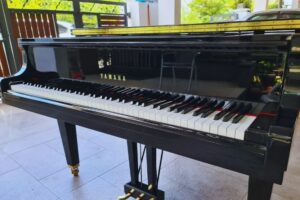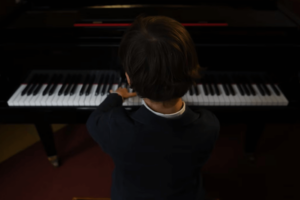Yamaha is one of the best producers of high-quality baby grand pianos at a price point that’s difficult to beat. In this Yamaha baby grand pianos review, I’ll list all of their important specs and features to help you decide if they’re perfect for you.
What’s the most compact Yamaha baby grand piano? The GB1K is currently Yamaha’s smallest and most affordable grand piano. It’s only five feet long, which places it under the category of “baby grand piano.”
Read on to learn more about the different Yamaha baby grand pianos, specifically their main features and specs.
Also, we hope you find the links here useful. We may get a commission if you purchase something through a link on this page, so thank you!
About the Yamaha Baby Grand Pianos Specs and Review
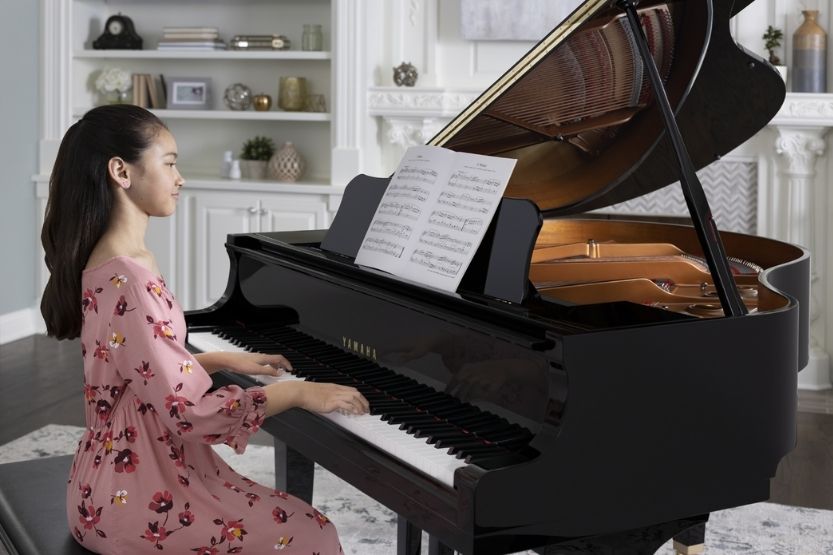
The modern piano is available in different sizes, with one of the most popular being the ‘baby’ grand. It was Steinway & Sons that created the first baby grand piano in 1905—the Steinway & Sons Model A.
The Steinway & Sons Model A is 6-foot long—a foot longer than the modern-day baby grand pianos. Today, a baby grand piano typically weighs 550 pounds and measures 4 feet 6 inches to 5 feet 3 inches long.
Baby grand pianos are a good option for beginner, intermediate, and casual piano players. And because of their compact and small size, they can fit into rooms or homes with limited space without sacrificing the quality of their sound and functionality.
Yamaha’s line of baby grand pianos features three different sizes, from 5 feet to 5 feet 8 inches long. They’re not only sleek and beautiful, but Yamaha made sure they still produce exceptional sound and resonance using the best technology in instrumental engineering and production.
How Much Is a Large Grand Piano?
Different Series of Yamaha Baby Grand Pianos
Now, let’s explore the different series of Yamaha baby grand pianos below.
1. GC1 Series
The GC1 baby grand piano is exclusively manufactured in Hamamatsu, Japan, where Yamaha makes most of its top-notch grand and upright pianos.
If a Yamaha GC3 or GC5 is too big for your space, the GC1 could be a better option for you. It measures 5.3 feet (161 centimeters) long and 4.9 feet (149 centimeters) wide. But weighing 639 pounds (290 kilograms) might take more than three people to carry it.
When it comes to its performance, it doesn’t disappoint. In fact, some believe that it’s better than Yamaha’s GB1K piano—which is shorter than the GC1 by 10 centimeters—or other baby grand pianos manufactured in China and Indonesia.
2. GC2 Series
From the keyboard to the tail, the GC2 measures 5 feet and 8 inches. It’s five inches longer than the GC1, which could make a difference to how much better (or richer) the sound it makes. But both models possess excellent performance, as far as the keyboard is concerned, so it’s really a matter of personal preference.
Another similarity between the GC1 and GC2 is they both feature Yamaha’s Silent System. This technology prevents the hammers from striking the strings. Instead, a sensor technology catches the keys’ movements then delivers them to the digital tone module.
This allows you to practice anytime you want with the privacy of headphones, so you don’t disturb other people.
3. GB1K Series
The GB1K is the best-selling baby grand piano in the United States. At only 5 feet in length, it’s Yamaha’s most compact and smallest acoustic grand piano. And if you’re looking for a more affordable starter model, this one’s usually a good option.
Despite its small size, the GB1K still offers the same sound quality, power, and craftsmanship that Yamaha is known for. The smooth, responsive keyboard of the GB1K will surely make you want to keep playing and improving.
However, it could create a somewhat “thuddy” sound. Small pianos tend to have shorter and stiffer strings, causing less clarity in the bass.
4. CX Series
The new CX line of acoustic grand pianos results from more than two decades of careful research and the incorporation of the latest breakthroughs in grand piano design. Out of all the baby grand pianos under this series, the C1X (5 feet 3 inches) is considered the smallest.
For the CX Series grand pianos, Yamaha removed the unnecessary and redesigned them to enhance functionality. The thickened frame doesn’t only protect the internal parts, but it also helps in the tone.
The revolutionary music wires create a thicker tone, especially in the mid and upper registers. The company also updated the soundboard for better projection and response.
Again, what’s the most compact Yamaha baby grand piano? At present, the smallest and most affordable Yamaha grand piano is the GB1K. It is five feet in length, putting it under the “baby grand piano” category.
Click here to see this OneOdio Wired Over Ear Headphones Studio Monitor & Mixing on Amazon.
Yamaha Baby Grand Pianos Main Features
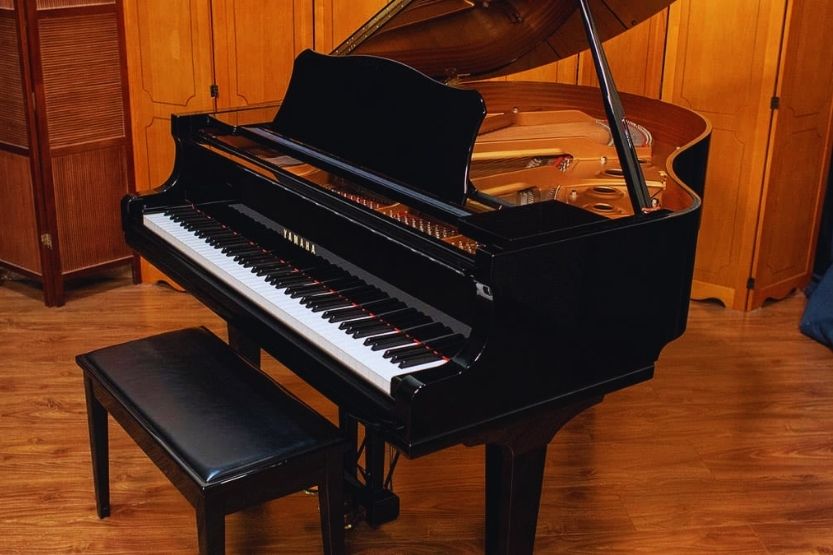
Each of these Yamaha baby grand pianos has common and specific features crucial to every pianist’s playing experience. Let’s take a look at the specs and features of these baby grand pianos:
1. Dimensions
| Model/Series | Length | Height | Width | Weight |
| GC1 | 5 feet 3 inches (161 centimeters) | 40 inches (101 centimeters) | 59 inches (149 centimeters) | 627 lbs (285 kilograms) |
| GC2 | 5 feet 8 inches (173 centimeters) | 40 inches (101 centimeters) | 59 inches (149 centimeters) | 674 lbs (305 kilograms) |
| GB1K | 5 feet (151 centimeters) | 39 inches (99 centimeters) | 57 inches (146 centimeters) | 574 lbs (261 kg) |
| C1X | 5 feet 3 inches (161 centimeters) | 40 inches (101 centimeters) | 59 inches (149 centimeters) | 638 lbs (289 kilograms) |
| C2X | 5 feet 8 inches (173 centimeters) | 40 inches (101 centimeters) | 59 inches (149 centimeters) | 671 lbs (304 kilograms) |
2. Technology
Yamaha baby grand pianos are packed with useful technological features that allow you to consistently play beautiful harmonies and melodies and recreate them in exact detail. Except for some models, like the C2X and GB1K, most of the Yamaha baby grand pianos feature three systems:
Disklavier ENSPIRE
After three decades of continuous innovation, Yamaha was able to develop the Disklavier ENSPIRE. This technology lets you record and playback your own performances—note for note.
Yamaha acoustic pianos with the Disklavier ENSPIRE technology are outfitted with a patented Optical Sensor System. These sensors work by measuring the movements and timing of the hammers, keys, and pedals, and then the system saves these data as a Standard MIDI File (SMF).
SILENT Piano™ Technology
The TransAcoustic™ Technology transforms your baby grand piano into a wonderful acoustic speaker by using the soundboard to adjust the volume. To use the TransAcoustic Mode, slide the middle pedal towards the left, then turn the TransAcoustic controller volume up to your desired level.
How does this technology work?
Whenever you depress the keys of your baby grand piano, the hammers strike the corresponding strings. This action causes the strings to resonate at the same time. The sound initially produces usually small, but the soundboard amplifies it to give you a whole new way of enjoying the piano.
3. Sound Quality
If you have ever played a Yamaha grand piano before, you definitely know how bright and rich the tone it produces. These acoustic pianos’ beautiful and distinct sound quality can be heard today in different venues, including concert halls, schools, and recording studios.
Most of Yamaha’s grand pianos are crafted with duplex scaling and rich tonal character. This allows them to produce pitches and a sound quality that complements that of the piece being played.
In most cases, you can use them for different genres:
- Broadway Musicals,
- Jazz,
- Pop, and
- Rock.
They work great for attaining clear tones, especially in the repetitive sections of material and subtle pianissimo dynamics (meaning, how mellow or soft a piece of music should be played).
Click here to see this MiriamSong Professional Piano Tuning Kit on Amazon.
4. Aesthetics and Components
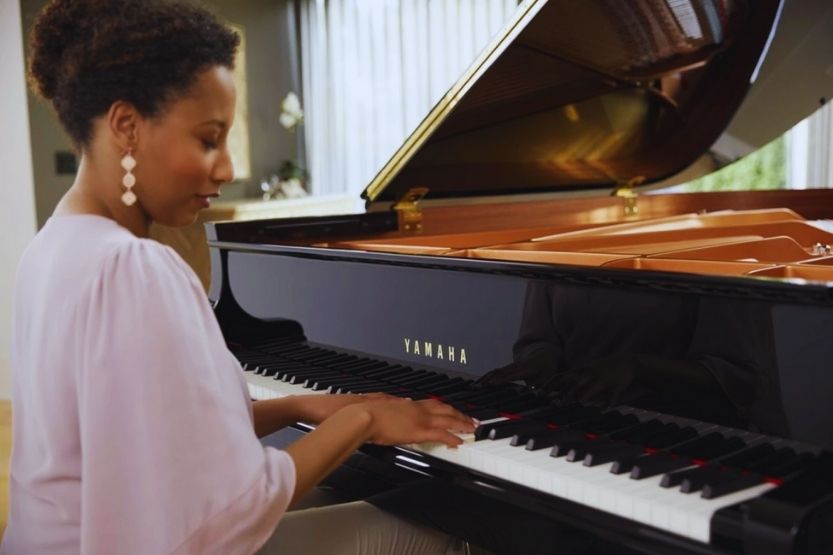
In terms of outward design, Yamaha baby grand pianos could easily compete with more expensive brands, like the FAZIOLI. They’re elegant, sleek, and beautifully finished.
Yamaha baby grand pianos are available in these finishes:
- Georgian
- French Provincial
- Polished Ebony
- Polished Mahogany
- White (Polished)
- Polished American Walnut
- Satin Ebony
- Satin American Walnut
Click here to see this MusicNomad Complete Care for Gloss Pianos (MN132) on Amazon.
5. Back Frame
Acoustic pianos need tuning every six or twelve months to create the correct pitch and hit the correct notes. The sturdier the back frame of a piano, the longer it stays in tune.
The back frame of Yamaha grand pianos is approximately twenty percent thicker than most standard grand pianos. The extra thickness provides exceptional support, which results in a richer, more resonant tone.
6. Music Wire
The music wire can greatly affect the timbre (the sound quality played on the instrument) and sustain of baby grand pianos. When combined with the thick back frame, these specialized wires, or “music wires,” contribute to the rich and harmonic sounds of the Yamaha baby grand pianos.
7. Soundboard
The soundboard of Yamaha acoustic pianos is usually made of a thin sheet of high-quality Sitka spruce or Japanese spruce.
This well-rounded tonewood undergoes several processes—combined with Yamaha’s best engineering practices and years of experience—to create a soundboard that easily vibrates and provides the best possible projection (or penetrating quality).
8. Frame
Yamaha doesn’t outsource the production of their acoustic piano frames. They use the vacuum process casting (or the V-process) to produce top-notch frames, which can withstand high-string tension (often twenty tons or greater). They also use a special type of coating to achieve the acoustic characteristics their grand pianos are known for.
9. Hammers
Unlike most makers of grand pianos, Yamaha produces many of its components with the help of its engineers. This means that even their piano hammers, which are crucial components for the sound of a piano, provide excellent sustain, tonality, and power. They’ve also been adjusted to work perfectly well with their line of small grand pianos.
Click here to see this Vekkia Music Stand Light on Amazon.
Conclusion – Yamaha Baby Grand Pianos
Are Yamaha baby grand pianos good? There’s no doubt that Yamaha makes one of the best baby grand pianos on the market. It’s often the go-to brand for pianists who want an affordable acoustic piano without sacrificing quality.
But when buying one for yourself, don’t focus too much on the size. Remember: The design and build quality have more impact on the dependability and performance of a piano.
Read next:











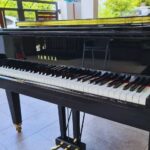
![Yamaha Grand Pianos [Specs and Review] Yamaha Grand Pianos](https://musicalinstrumentpro.com/wp-content/uploads/2021/08/Yamaha-grand-pianos-150x150.jpg)
![Yamaha Hybrid Pianos [Specs and Review] Yamaha Hybrid Pianos](https://musicalinstrumentpro.com/wp-content/uploads/2021/08/Yamaha-Hybrid-Pianos-150x150.jpg)
![Yamaha Upright Pianos [Specs and Review] Yamaha Upright Pianos](https://musicalinstrumentpro.com/wp-content/uploads/2021/08/Yamaha-Upright-Pianos--150x150.jpg)
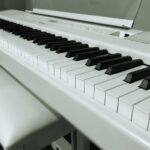
![Yamaha Digital Pianos [Specs and Reviews] Yamaha Digital Pianos](https://musicalinstrumentpro.com/wp-content/uploads/2021/09/Yamaha-Digital-Pianos-150x150.jpg)

